English summary of my website about family in Demerara.
updated the 15th of September 2015
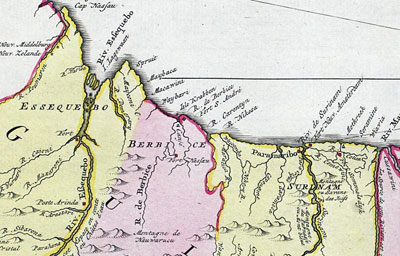
1773 d Anville. Overview of Dutch Colonies on the " Wild Coast"
|
The website about my family history including the page relating to the former Dutch colony Essequebo-Demerara (Demerary/Demerari, now part of Guyana in South America) is written in Dutch which is a language not mastered by many people globally. Therefore this summary describes in English specific findings which I believe may be of general interest to a broader group. My sources which are to a great extend in Dutch are listed and partly accessible via the Dutch page.
I want to acknowledge the help I received from Paul Koulen and the team of Abe de Jong professor corporate finance en governance of the Rotterdam School of Management.
|
My known family history with the one time Dutch colony Essequebo-Demerara dates back to 1780. Days of the American war of independence (1775-1783). The Dutch as well as the French were supporting America and hence, considered enemies by England. When a British ship seized a Dutch vessel they also took all documents, including personal letters. That is how the letter of my relative Willem Eeftinck former carpenter (born approx 1749 in Arnhem, The Netherlands) addressed to his parents and intended to be delivered via safe hand by the ships captain to his brother in law (my ancestor George Schattenkerk) living in Amsterdam, ended up for centuries in an almost forgotten archive in London. These letters have recently been discovered, scanned and made available to the general public via internet by a.o. the University of Leiden.
|
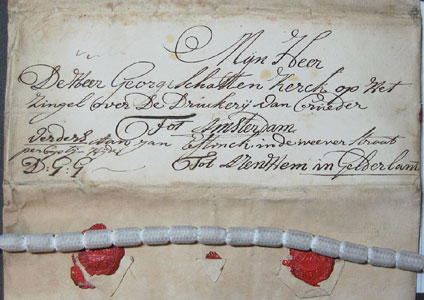
|
Willem writes the 1780 letter from the island Borsselen in the Demerara river (at the time the administrative center of that part of the colony). It mentions his acquaintance with a girl whom he intends to marry. The girl has consented but the problem is her guardian (she was an orphan) who opposes the alliance because of his modest financial status. She could do much better in his opinion. Willem mentions that he has taken legal issue with this guardian and confidently predicts that he will visit his parents the following year with his wife. He further mentions his cotton plantation which he estimates will provide 6000 pounds in cotton weight at the end of the year. His 125 acre cotton plantation is believed to have started in April 1780 near the mouth of creek Coerabana east of the river Demerara . Whether he visited his parents the following year or later or married the lady in question I don 't know for sure although I am inclined to believe the latter. Any way he did marry Johanna Elisabeth Blondel (born approx 1761 in Demerara) some time later. She is believed to be a natural, but recognized daughter (presumably of mixed blood), of the planter Jan Blondel. The couple had a son called Jean Charles Philippe in 1788.
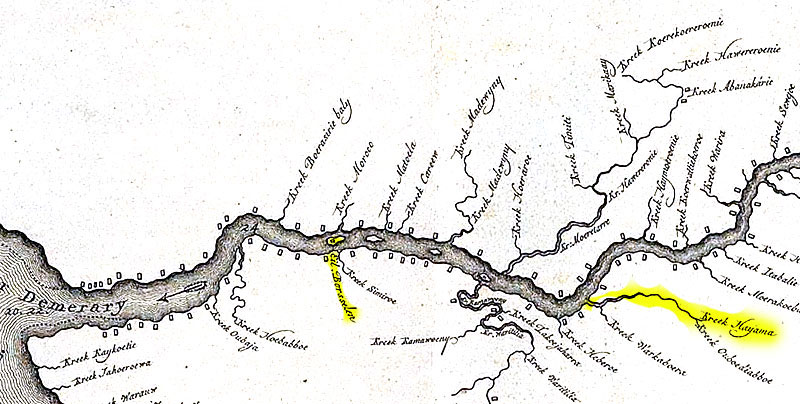
Map of Schey 1770. In yellow the Island Borsselen and a piece of land at the Hayama Creek which was sold by the heirs of Eeftinck in 1818. T
The father of Willem 's wife, Jan Blondel, is thought to have founded the plantation Blygezigt (Meaning in this context Pleasant or Fair view) around 1767. It is located on the East Coast nearby the mouth of the Demerara river and between the plantations later called The Kitty and Bel Air in what is now Georgetown.
Blondel sells Blygezigt in 1772 to Jozeph de la Chau en Diederik Paridon Meijer for 40,000. Guilders However in 1776 the plantation appears to be in the Blondel family again when half of its ownership is passed to the three under aged children from his former wife the late Cornelia Appelkrans. Charles Desbarats, married to his daughter Maria Catharina (born approx 1758 in Demerara), is acting party on behalves of his wive and the other children Blondel-Appelkrans. When Blondel dies around 1779 Desbarats is in charge as excuteur testamentary and guardian of the two under aged children Blondel-Appelkrans. In 1783 Blygezigt is 100% property of to the Children Blondel with Desbarats in charge on their, and his own, behalves. On a map of 1784 the name of Willem Eeftinck (spelled Ettink) appears as owner and/or manager of Blygezigt. On later maps his name is spelled more correctly.
Charles Desbarats was originally a surveyor. His name appears on many maps now in the Dutch National archives, made around 1776 often together with Hendrik van Cooten. Later or meanwhile he became planter with coffee plantation L' Heureuse Avanture. The couple Desbarats-Blondel had a son Charles Philippe in 1783 who is believed to have died young.
Meanwhile around 1781 the colony was first overrun by the English which were driven away in 1782 by the French who returned it to the Dutch in 1784.
In 1785 both Desbarats and Eeftinck signed a petition to the authorities in the Netherlands (Holland) complaining about the weak local government. Desbarats and wife leave for France in 1790. The next year Eeftinck and his wife also think about leaving as stated in their last will, dated 17th of March 1791, but it took till 1794 for Willem Eeftinck to return to The Netherlands, retiring at the age of 45 (!), where he settled in a mansion just outside the village of Zwammerdam in the province of South Holland called appropriately Buitendorp. He had apparently not sold the plantation. Why ? Who managed Blygezigt in his absence ?
Unfortunately shortly after the arrival of Willem in The Netherlands they were occupied by the French and Demerara since 1796 by the English. This would have made attending to Blygezigt for Eeftinck difficult to say the least. Willem Eeftinck died early January 1802 around the age of 53 after having been ill for a number of years from a painful disease, leaving his son and wife.
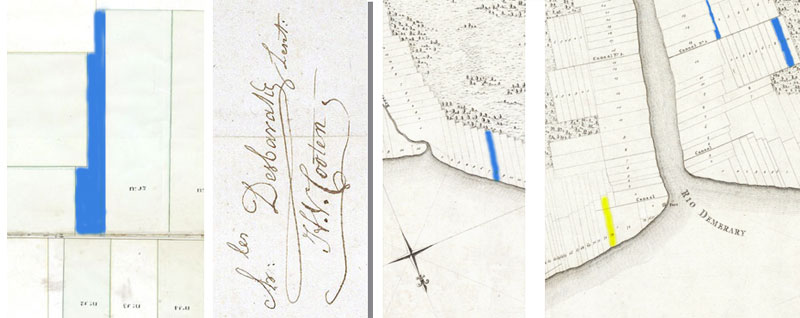
Left-hand map from 1776 with blue the plantation L' Heureuse Avanture then property of Charles Desbarats drawn by himself and
Hendrik van Cooten" (signatures of both). Right-hand map of 1792 with Blijgezigt in yellow and the property of Sabathier in blue.
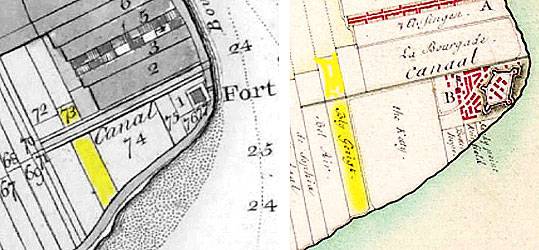
Mouth of the Demerara river with the plantation Blygezigt (yellow) on a map of 1798 and 1802 with the plantation names.
A few weeks after the death of Willem Eeftinck, in February of 1802, his house in Zwammerdam was already advertised to be sold by execution on the 27th of that month by a certain Mr J.C. Otto, real estate broker based in Amsterdam, but shortly afterwards that advertisement was withdrawn again. Although there was a short interlude of the British occupation of Demerara between December 1802 until September 1803. It took till March 1804 before the plantation Blygezigt was put up for sale instead of the house. Again via the same Mr Otto and handled locally by a Mr. J.W. Prins. But also in this case the plantation was not sold. One explanation is that there was a mortgage on either the house or the plantation or both and its lender sought security or wanted otherwise his money back. If need be by selling the collateral using Otto to put pressure on the discussion.Taking into account the poor state of the economy at that time it is conceivable that all parties would lose by premature selling and a settlement was finally agreed based on the future proceedings of the plantation. Maybe I am wrong with those assumptions but fact is that Otto was appointed at some time before 1812 as business representative of the widow Eeftinck with J.W. Prins as local administrator for Blygezigt. A situation which changed in 1814.
The only surviving child of the late Willem Eeftinck, Jean Charles Philippe, died in 1806 at the young age of 18 of what is stated as rheumatism, leaving his mother heartbroken. Jacob Schattenkerk also living in Zwammerdam and nephew (via her husband) of the widow Eeftinck-Blondel, named his second son born in 1807 in full after him, leading in time to the double name of Eeftinck Schattenkerk in my branch of that family.
In an international settlement after the defeat of Naopleon in 1814 the Dutch colonies Essequibo-Demerara and Berbice were ceded to England. With the status of the colony clear, control of the plantation owners could now be better exercised. Presumably the mortgage was paid by then because Jacob Schattenkerk was in that year appointed as the widows general representative taking over from J.C. Otto. Jacob then appointed 27 year old Nicolaas Sabbathier (son of a family friend of the Blondel family) and Jacob Schoemaker as the local team to run Blygezigt. In 1816 Schattenkerk was not satisfied with the performance of Sabbathier and replaced him with Gerrit Timmerman. When the widow Eeftinck passed away at the end of 1816 she left her estate to her nephew Jacob Schattenkerk and a sister of her husband with Schattenkerk in charge.
Finally on the 6th of July 1818 the plantation was sold to Messrs. Rodie , Shand, and John Staunton by the local team, Schoemaker and Timmerman, on behalf of the heirs of the widow Eeftinck (Efting).
Some scattered pieces of information of what happened afterwards: In 1821 the plantation was advertised for sale in the case of Henery versus Johnstone, in 1824-1825 Blygezigt was mentioned in an execution sale advertisement, in 1835 Blygezigt and neighbour plantation Bel Air were transferred to Charles and William Shand. In 1943 a number of plantations including Bel-Air and Blygezigt are in possession of the Corentyne Sugar Company, Ltd.. Only a small part is still used for sugar, there are housing lots and small pieces of land with a.o. rice fields and pasture land.
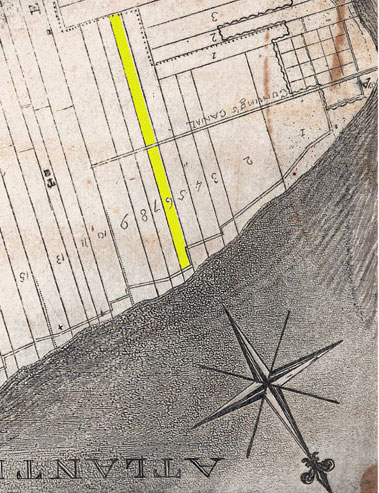 ... ...
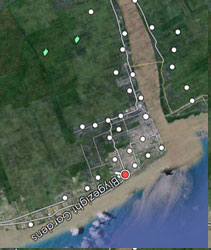
Detail of a map from 1823 (turned 180 degrees). The Cumming Canal (named after a previous owner) has been extended. Last is the situatiom on April 2015 (mapcarta.com/19104344)
Back to Blondel daughter Maria Catharina and Charles Desbarats. In 1796 they were residing in Bordeaux, France, requesting a passport to visit Hamburg in Germany, traveling with their adopted daughter Maria Cornelia Bellij (born approx 1772 in Demerara). and 9 year old Nicolaas Sabbathier (see above). At some time thereafter they moved to the Netherlands where they took residence in Maarssen (Province of Utrecht). Their adoptive daughter and nephew of her brother in law Jacob Schattenkerk liked each other and got married in 1805. When Desbarats died in 1808 his widow moved to Zwammerdam to be close to her sister and adopted daughter. When she passed away in 1815, having no surviving children of her own, she left the main part of her estate in equal parts to the her adopted daughter and husband and her sister. The later was only entitled to a life rent from her part, the principal sum to be passed to the couple Schattenkerk-Bellij after her death.
In the estate of the widow Desbarats-Blondel was a significant mortgage of 13.054 guilders with a yearly interest of 8% dating back to 1790 (when Desbarats left Demerara) on part of the coffee plantation l' Heureuse Avanture (60 acre) and a much larger piece of nearby (uncultivated ?) land of 500 acre both belonging to the Sabbathier family. However in 1814 there appears to be some 14 years of interest due ! In 1820 Jacob Schattenkerk and his wife requested Arend Hendrik Walstab in Georgetown to deal with this and in 1828 they finally ask him to sell the mortgage or the collateral. Unfortunately I don 't know any further details at his point.
If you have any information to contribute to the brief history on this web-page I will be grateful. In turn I will try to answer any questions you may have on this subject.
For your information, my connection to Willem-Eeftinck, spanning seven generations is as follows: Schattenkerk- Eeftinck (sister of Willem) / Schattenkerk-Bellij (adopted daughter of Desbarats-Blondel)/ Eeftinck Schattenkerk- Kwakernaak / Eeftinck Schattenkerk - Boers/ Hees - Eeftinck Schattenkerk / De Jongh - Hees / De Bie - De Jongh/
Henk de Bie.
|





 ...
...
